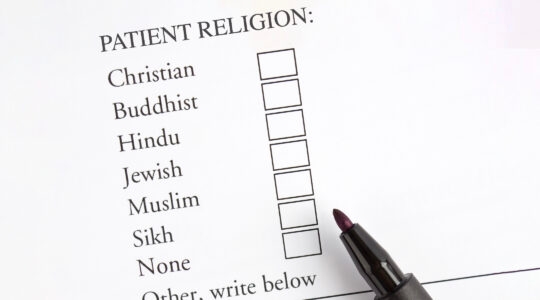In the first public criticism of the newly released “Jewish Community Study of New York: 2011,” a leading demographer is raising questions about the report’s methodology and data, as well as the validity of its findings.
Len Saxe, director of the Steinhardt Social Research Institute and the Cohen Center for Modern Jewish Studies at Brandeis University, says that while he agrees with the findings that show the Jewish population of New York has increased, he believes much of the overall picture is inaccurate. He claims that the study overestimates the Orthodox numbers and underestimates the non-Orthodox.
“Key outcomes of the study don’t seem to reconcile with ‘hard,’ non-survey data,” Saxe told The Jewish Week.
The study, commissioned by UJA-Federation of New York and released last month, found that Orthodox Jews make up 32 percent of the Jewish community of the five boroughs, Long Island and Westchester; that 37 percent of Jews define themselves as “Just Jewish”; and that the Reform and Conservative movements each lost about 40,000 members since the last New York study a decade ago.
The survey also found that 20 percent of those in Jewish households are poor.
The widely reported findings set off a number of communal and media responses that voiced concern with the direction of a community that appears to be moving increasingly Orthodox in one direction and secular in the other direction, with the center falling out.
But if Saxe’s analysis is correct, the numbers of Orthodox could be significantly less than the 493,000 claimed in the survey. And the non-Orthodox population could be significantly larger than the study reports.
Saxe said he did not want to launch another round of disputes between and among demographers, which has become a common occurrence after the release of major Jewish population studies. He and Steven M. Cohen, a sociologist and one of the authors of the UJA-Federation study, have clashed in the past over methodology. Saxe tends to have more optimistic views about the size and vitality of the American Jewish community, while Cohen is generally more concerned about the impact of intermarriage and assimilation.
This week Saxe was guarded in his criticism of the UJA-Federation study, preferring to raise “anomalies” about the study rather than express outright criticism.
One apparent inconsistency he raised focused on the figures for the number of Orthodox children, age 5 to 17, in day schools.
The study reported the figure at 145,000 in the five boroughs, Long Island and Westchester. Saxe, citing the 2008-2009 report for the Avi Chai Foundation authored by Marvin Schick, a consultant for the foundation and an acknowledged expert on day school population figures, says there are far fewer: about 100,000.
But Schick himself, interviewed on Tuesday, says he believes the most accurate figure would be somewhere in the middle, about 120,000.
“Saxe is right that the UJA-Federation study’s numbers are way too high, but his numbers are too low,” Schick said. He cited an “apples and oranges” factor in the difference between the number of day school students who attend schools in the eight-county area of New York, which he believes to be about 100,000, and the number of day school students who live in the same eight-county area, which he estimates to be 120,000.
Schick said the New York State Department of Education figures on day school enrollment are reliable and are “totally compatible with mine.”
Another indication that the UJA-Federation study’s numbers are inflated, according to Schick, is that the report says there are 3,000 Reform children in New York day schools, which he says is “impossible.”
Saxe says the discrepancy between the UJA-Federation study — which reports 145,000 day school students — and his 100,000 figure, based on research by Schick, New York State and others, “is far greater than could be attributed to a sampling error.”
He believes the study not only overestimates the day school enrollment but underestimates the number of Birthright Israel alumni in New York, raising “a broader question about the reliability of the community survey data.”
The report refers to 11,000 non-Orthodox New York alumni of Birthright, the free Israel trips for those ages 18 to 26. Saxe, who oversees numerous studies of Birthright alumni, says the more accurate number is 50,000.
But Cohen said the 11,000 number refers to “the weighted projection number” the researchers factored in, and that they estimate there are about 45,000 Birthright alumni in New York, basically consistent with Saxe’s numbers. Cohen said there might be some adjustments required regarding day school enrollment and other specific numbers in the in-depth study, but that overall he is confident that “the main contours of our findings” are solid.
“As a social scientist, I approach this work with a sense of humility,” said Cohen, adding that he welcomes input from Saxe and others in the field.
He said the full data would be released as soon as possible after the final two reports related to the survey are released.
“Every 10 years, demographers debate the methodologies employed and the findings of population studies,” noted John Ruskay, executive vice president and CEO of UJA-Federation. “We welcome the continued effort to understand and refine both the numbers and the implications of the recently released ‘Jewish Community Study of New York.’ That remains one of our objectives: to provide a basis to better understand where we are today and how we can most effectively strengthen the Jewish future.”
If, when the full data is released, Saxe’s criticisms are born out, it might prove embarrassing to UJA-Federation regarding its methodology. But Saxe’s theory, that the Orthodox were overreported and the non-Orthodox were underreported, would underscore that the outreach and Jewish identity projects sponsored by the federation were more successful, perhaps, than initially thought.
The New York Jewish Week brings you the stories behind the headlines, keeping you connected to Jewish life in New York. Help sustain the reporting you trust by donating today.




